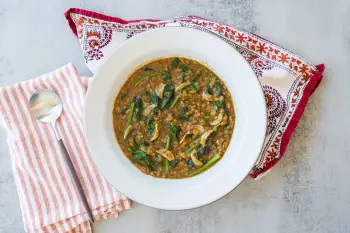
 198 minutes
198 minutesA tangy and flavorful fermented cabbage dish that serves as a versatile condiment or snack.


Red Cabbage, quartered and cored, thinly sliced
0 lb
teaspoons
Caraway Seeds, optional
teaspoons
Filtered Water
cups
tablespoons
1. Prepare the Cabbage
Begin by removing the outer leaves of the cabbage, then quartering and coring it. Slice the cabbage thinly to yield about 5 cups of shredded cabbage.
2. Massage the Cabbage
Transfer the shredded cabbage into a large bowl. Add the sea salt and caraway seeds if using. Massage the salt into the cabbage until it looks wilted and juicy.
3. Pack the Cabbage into a Jar
Pack the cabbage firmly into a 2-quart glass jar, ensuring the liquid covers the cabbage. If needed, mix 1 tablespoon of salt with a cup of filtered water to create additional brine and pour it over the cabbage until submerged.
4. Weight and Cover
Place a weight over the cabbage to keep it submerged. Cover the jar with a dish towel to keep out dust and pests.
5. Ferment and Store
Let the cabbage ferment at room temperature for about a week. Check periodically and remove any scum that forms. Once it reaches the desired flavor, transfer the jar to the refrigerator where it will keep for up to six weeks.
Use high-quality non-iodized salt. The optimal salt concentration for fermentation is about 2% of the cabbage's weight. Weighing ensures success.
Opt for fresh, organic, and preferably locally-sourced cabbage. Green cabbage is the classic choice, but mixing in some red cabbage can add color and nutritional benefits.
The ideal fermentation temperature is around 65-75°F (18-24°C). Keep the vessel out of direct sunlight and maintain a consistent temperature.
Firmly pack the cabbage into your fermentation vessel to eliminate air pockets that can lead to spoilage. Compress the cabbage effectively with a kraut stamper.
Use weights to keep the cabbage submerged in brine and cover the vessel with a clean cloth to keep out contaminants while allowing gases to escape.




Comments (0)